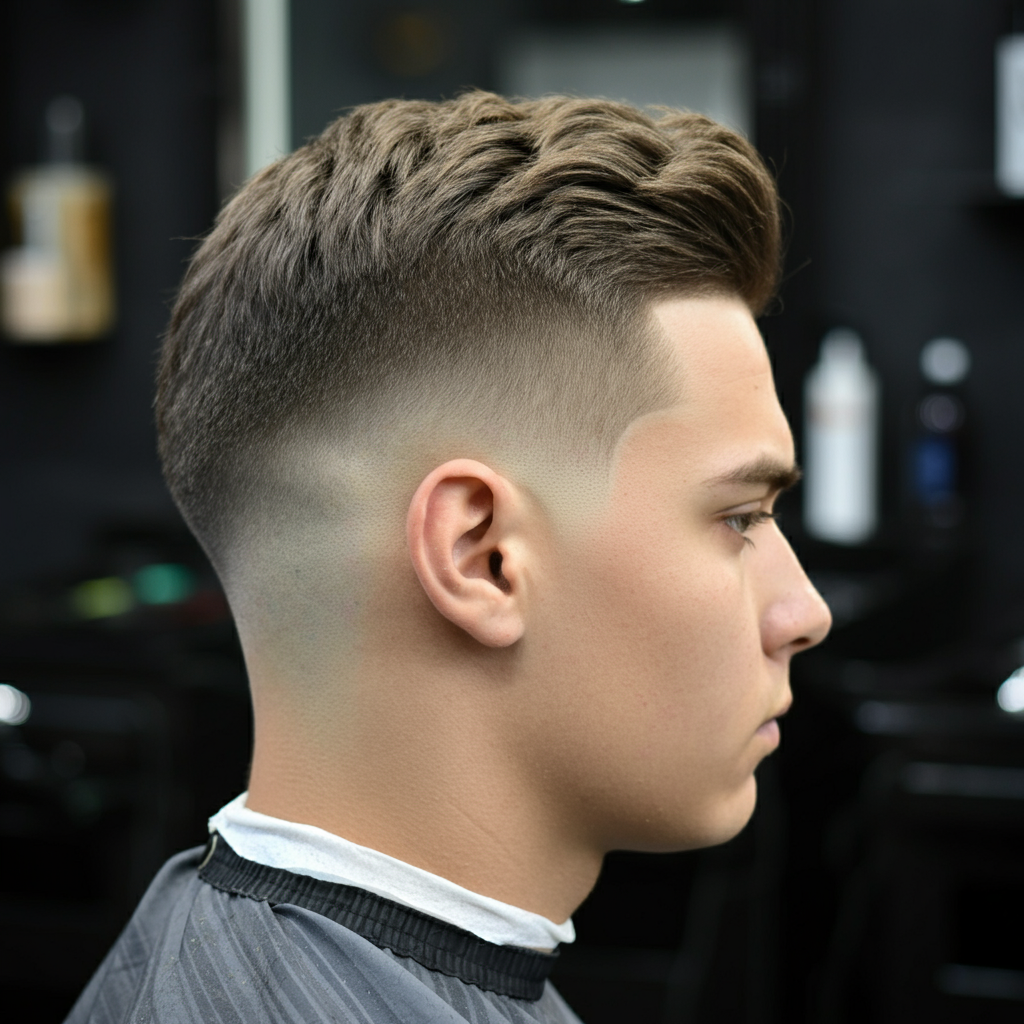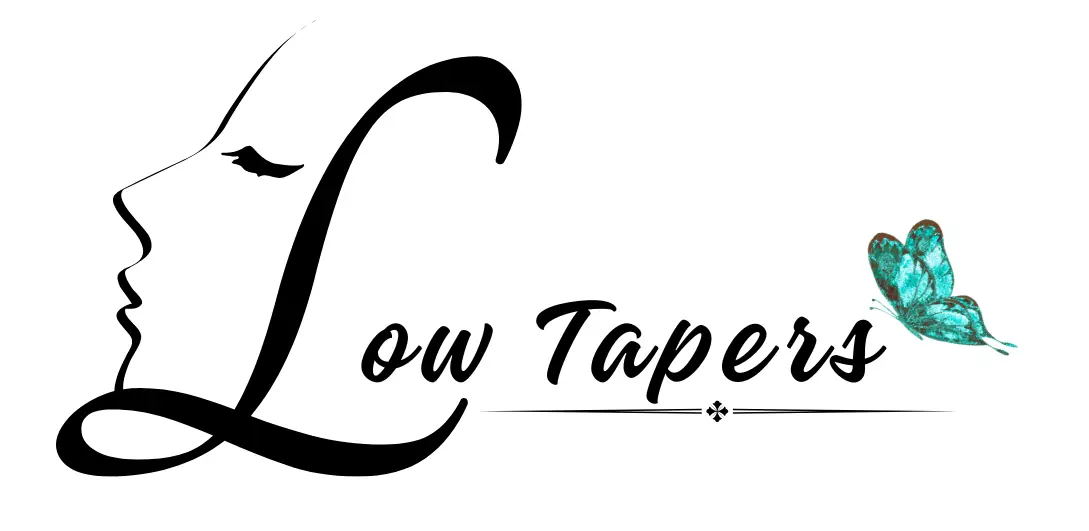
The low taper fade has become one of the most requested haircuts in barbershops across America. This sophisticated style offers the perfect balance between professional polish and contemporary edge, making it a go-to choice for men who want a clean, versatile look that works from the boardroom to weekend casual.
Unlike more dramatic fade styles, the low taper fade provides a subtle transition that starts just above the ears, gradually blending shorter hair at the sides and back while maintaining longer length on top. This understated approach creates a refined aesthetic that complements virtually any face shape and hair type.
Whether you’re considering your first fade or looking to switch up your current style, understanding the nuances of the low taper fade will help you communicate effectively with your barber and achieve the exact look you want.
What Is a Low Taper Fade?
A low taper fade is a haircut technique that gradually reduces hair length on the sides and back of the head, starting the transition just above the ear level. The “low” designation refers to where the fade begins—much lower than mid or high taper fades, which start higher up on the head.
The taper fade creates a seamless blend from longer hair on top to progressively shorter lengths down the sides and back. This gradual transition gives the haircut its signature clean, polished appearance without the stark contrast of more aggressive fade styles.
Professional barbers achieve this look using different clipper guard sizes, typically starting with a longer guard at the top of the fade area and switching to shorter guards as they work downward. The result is a smooth gradient that enhances the overall shape and structure of the haircut.
Low Taper vs Mid Taper vs High Fade: Understanding the Differences
The primary distinction between low taper, mid taper, and high fade haircuts lies in where the transition begins on the head:
Low Taper Fade: Starts just above the ears, creating the most subtle and conservative fade option. Perfect for professional environments and men who prefer understated styling.
Mid Taper Fade: Begins around the temples, offering more contrast than a low fade while remaining versatile for most occasions.
High Fade: Starts well above the temples, creating dramatic contrast and a bold, modern appearance that works best in casual settings.
The low fade haircut remains the most versatile option, suitable for all hair types and professional requirements whilst still providing contemporary appeal.
Best Low Taper Fade Styles for Different Hair Types
Low Taper Fade Curly Hair
Men with naturally curly hair can benefit enormously from a low taper fade. The technique removes bulk from the sides whilst preserving the texture and volume on top. For tight curls, the fade helps create definition and prevents the sides from appearing overly dense.
The key to styling curly hair with a low taper is working with your natural texture rather than against it. Use a curl-defining cream on damp hair and scrunch gently to enhance the curl pattern. The contrast between the neat sides and voluminous curls on top creates an eye-catching, balanced look.
Straight Hair Low Taper Fade
Straight hair provides the perfect canvas for showcasing the precision of a low taper fade. The clean lines are more visible with straight hair, making the barber’s technique particularly apparent.
For straight hair, consider pairing your low fade with classic styles like a side part, slicked-back look, or textured crop. The fade provides structure whilst the straight hair on top can be styled in numerous ways depending on the occasion.
Low Taper Fade with Textured Hair
Textured hair—somewhere between straight and curly—works exceptionally well with low taper fades. The natural movement in the hair creates interest on top, whilst the faded sides provide a clean foundation.
To enhance texture, use a lightweight styling paste or sea salt spray. These products add grip and definition without weighing the hair down, allowing for natural movement and flexibility throughout the day.
Popular Low Taper Fade Combinations
Modern Mullet with Low Taper
The modern mullet has experienced a significant resurgence, and pairing it with a low taper fade creates a contemporary twist on this retro style. The fade keeps the sides neat whilst the longer back maintains the mullet’s characteristic silhouette.
This combination works particularly well for men with thick hair who want to embrace current trends whilst maintaining some professional appeal. The low fade ensures the style remains workplace-appropriate whilst the mullet adds personality and edge.
Low Taper with Quiff
A quiff paired with a low taper fade creates a classic yet contemporary look. The volume and height of the quiff contrast beautifully with the clean, faded sides. This style works well for oval and square face shapes, as the height adds length to the overall appearance.
To achieve this look, use a volumising mousse on damp hair, then blow-dry using a round brush to create lift at the front. Finish with a medium-hold pomade for shine and control.
Crew Cut Low Taper

The crew cut with a low taper fade offers maximum versatility with minimal maintenance. This combination provides a professional appearance suitable for any environment whilst remaining easy to style.
The short length on top paired with the gradual fade creates a balanced, proportional look that works for all face shapes. It’s an excellent choice for men with thinning hair, as the overall short length minimises the appearance of hair loss.
How to Ask Your Barber for a Low Taper Fade
Clear communication with your barber is essential for achieving the perfect low taper fade. Here’s how to ensure you get exactly what you want:
Be Specific About the Starting Point: Tell your barber you want the fade to begin just above your ears. Some barbers interpret “low” differently, so being precise helps avoid confusion.
Discuss the Length on Top: Specify how much length you want to maintain on top and whether you prefer any particular style (textured, slicked back, or natural).
Mention Your Hair Type: Let your barber know if you have any cowlicks, thinning areas, or unusual growth patterns that might affect the cut.
Bring Reference Photos: Visual references eliminate guesswork and help ensure you and your barber are on the same page.
Discuss Maintenance: Ask about the recommended time between cuts to maintain the look, typically every 3-4 weeks for optimal appearance.
Styling and Maintenance Tips
Daily Styling
Most low taper fade styles require minimal daily styling. For textured looks, apply a small amount of styling paste to damp hair and tousle with your fingers. For sleeker styles, use pomade or gel to achieve the desired finish.
Product Recommendations
- For Texture: Lightweight styling paste or sea salt spray
- For Sleek Styles: Medium-hold pomade or styling gel
- For Curly Hair: Curl-defining cream or leave-in conditioner
- For Volume: Volumising mousse or texture spray
Maintenance Schedule
To keep your low taper fade looking sharp, schedule appointments every 3-4 weeks. The fade will begin to lose its definition as hair grows, particularly around the ears and neckline.
Between cuts, maintain the neckline by keeping it clean-shaven or neatly trimmed. This small detail makes a significant difference in the overall appearance of the haircut.
Who Should Consider a Low Taper Fade?
The low taper fade works well for virtually any man, but it’s particularly suitable for:
- Professionals who need a polished appearance for work
- Men with thick hair who want to reduce bulk whilst maintaining length on top
- Those new to fade haircuts who prefer a subtle introduction to the style
- Anyone seeking versatility in their hairstyle for different occasions
The style complements all face shapes, though men with round faces might benefit from additional height on top to elongate their appearance.
Transform Your Look with a Low Taper Fade
The low taper fade represents the perfect intersection of classic barbering techniques and contemporary style preferences. Its versatility makes it suitable for professional environments whilst providing enough modern appeal to keep you looking current and stylish.
Whether you pair it with textured hair on top, sleek styling, or natural curls, the low taper fade provides a clean foundation that enhances rather than overwhelms your chosen style. The subtle nature of the fade means it grows out gracefully, making it a practical choice for men with busy lifestyles.
Ready to try this versatile haircut? Book an appointment with a skilled barber who understands fade techniques, and don’t forget to bring reference photos to ensure clear communication about your desired outcome.
